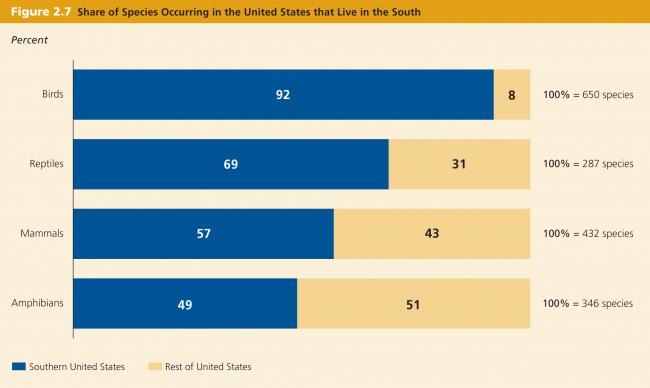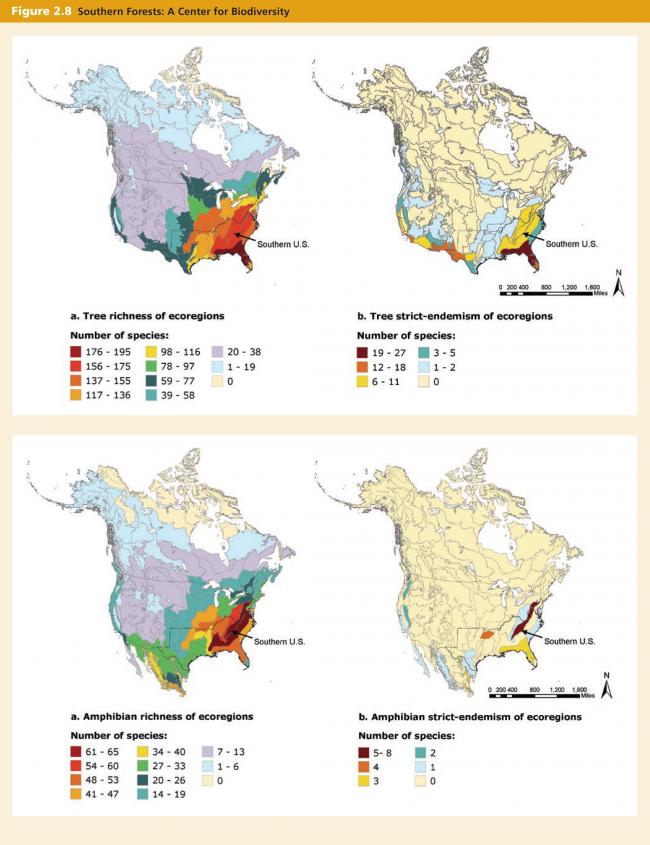Biodiversity
Southern forests are important for biodiversity. Healthy forests offer food, water, shelter, nesting sites, and migration paths for birds, as well as land animals. Forests located near streams and rivers maintain cool water temperatures during summer to the benefit of young fish and other organisms. Rotting wood and leaves serve as a foundation for ecosystem food chains. Although biodiversity is not itself an ecosystem service, it underpins the supply of ecosystem services.
A significant share of plants and animals found in the United States occur in the South (Figure 2.7). In particular, the South contains approximately:
- 595 species of birds, including turkey, woodpeckers, and warblers;
- 246 species of mammals, including the black bear, bobcat, and raccoon;
- 197 species of reptiles, including the southern painted turtle, glass lizard, and timber rattlesnake;
- 170 species of amphibians, including the marbled salamander, southern leopard frog, and American toad; and
- More than 130 species of trees, including oaks, dogwoods, and pines.1
 Source: Wear and Greis 2002.
Source: Wear and Greis 2002.Since forests are the dominant natural ecosystem in the region, many of these species are forest-dependent or forest-adapted.
For trees, amphibians, and reptiles, the South hosts a high concentration of species richness—the number of species in a given area. The region is also a center of species endemism—the number of unique species found in a specific area but nowhere else (Figure 2.8).

- By protecting water quality in mountain streams, high-elevation forests in the southern Appalachians are a world center of salamander diversity, including 68 species of a unique group of lungless salamanders.2
- Coastal cypress swamps provide critical habitat for eastern North American populations of migratory and neo-tropical songbirds.
- Maritime forests on southern barrier islands are of critical importance for migratory birds.3
- The longleaf pine savanna—an open, park-like forest ecosystem originally covering much of the southeastern United States—is one of the most diverse North American ecosystems north of the tropics.
Combined, these factors make southern forests a biological treasure. For many people, this biodiversity is important in its own right—it has intrinsic value. For all people, this biodiversity is important because it helps underpin the supply of many ecosystem services.
-
Trani, Margaret K. 2002a. “Maintaining Species in the South.” In Wear, David N., and John G, Greis, eds. 2002. Southern Forest Resource Assessment. Gen. Tech. Rep. SRS-53. Asheville, NC: U.S. Department of Agriculture, Forest Service, Southern Research Station. ↩
-
White, P.S., S.P Wilds, and G.A.Thunhorst. 1998. “Southeast.” In Mac, M.J., P.A. Opler, C.E. Puckett Haecker, and P.D. Doran. 1998. Status and Trends of the Nation’s Biological Resources. 2 Vols. Reston, Va: U.S. Department of the Interior, U.S. Geological Survey. ↩
-
White, P.S., S.P Wilds, and G.A.Thunhorst. 1998. “Southeast.” In Mac, M.J., P.A. Opler, C.E. Puckett Haecker, and P.D. Doran. 1998. Status and Trends of the Nation’s Biological Resources. 2 Vols. Reston, Va: U.S. Department of the Interior, U.S. Geological Survey. ↩



